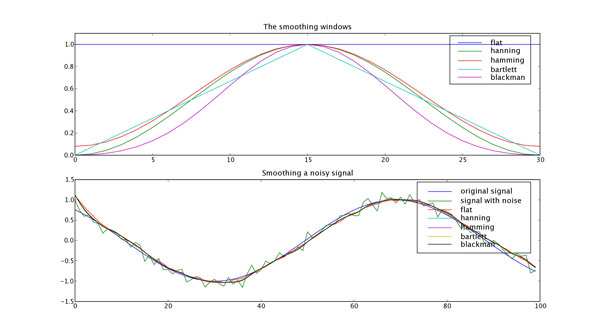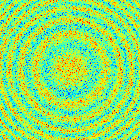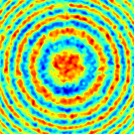Smoothing of a 1D signal
This method is based on the convolution of a scaled window with the signal. The signal is prepared by introducing reflected window-length copies of the signal at both ends so that boundary effect are minimized in the beginning and end part of the output signal.
Code
1 import numpy
2
3 def smooth(x,window_len=11,window='hanning'):
4 """smooth the data using a window with requested size.
5
6 This method is based on the convolution of a scaled window with the signal.
7 The signal is prepared by introducing reflected copies of the signal
8 (with the window size) in both ends so that transient parts are minimized
9 in the begining and end part of the output signal.
10
11 input:
12 x: the input signal
13 window_len: the dimension of the smoothing window; should be an odd integer
14 window: the type of window from 'flat', 'hanning', 'hamming', 'bartlett', 'blackman'
15 flat window will produce a moving average smoothing.
16
17 output:
18 the smoothed signal
19
20 example:
21
22 t=linspace(-2,2,0.1)
23 x=sin(t)+randn(len(t))*0.1
24 y=smooth(x)
25
26 see also:
27
28 numpy.hanning, numpy.hamming, numpy.bartlett, numpy.blackman, numpy.convolve
29 scipy.signal.lfilter
30
31 TODO: the window parameter could be the window itself if an array instead of a string
32 NOTE: length(output) != length(input), to correct this: return y[(window_len/2-1):-(window_len/2)] instead of just y.
33 """
34
35 if x.ndim != 1:
36 raise ValueError, "smooth only accepts 1 dimension arrays."
37
38 if x.size < window_len:
39 raise ValueError, "Input vector needs to be bigger than window size."
40
41
42 if window_len<3:
43 return x
44
45
46 if not window in ['flat', 'hanning', 'hamming', 'bartlett', 'blackman']:
47 raise ValueError, "Window is on of 'flat', 'hanning', 'hamming', 'bartlett', 'blackman'"
48
49
50 s=numpy.r_[x[window_len-1:0:-1],x,x[-1:-window_len:-1]]
51 #print(len(s))
52 if window == 'flat': #moving average
53 w=numpy.ones(window_len,'d')
54 else:
55 w=eval('numpy.'+window+'(window_len)')
56
57 y=numpy.convolve(w/w.sum(),s,mode='valid')
58 return y
59
60
61
62
63 from numpy import *
64 from pylab import *
65
66 def smooth_demo():
67
68 t=linspace(-4,4,100)
69 x=sin(t)
70 xn=x+randn(len(t))*0.1
71 y=smooth(x)
72
73 ws=31
74
75 subplot(211)
76 plot(ones(ws))
77
78 windows=['flat', 'hanning', 'hamming', 'bartlett', 'blackman']
79
80 hold(True)
81 for w in windows[1:]:
82 eval('plot('+w+'(ws) )')
83
84 axis([0,30,0,1.1])
85
86 legend(windows)
87 title("The smoothing windows")
88 subplot(212)
89 plot(x)
90 plot(xn)
91 for w in windows:
92 plot(smooth(xn,10,w))
93 l=['original signal', 'signal with noise']
94 l.extend(windows)
95
96 legend(l)
97 title("Smoothing a noisy signal")
98 show()
99
100
101 if __name__=='__main__':
102 smooth_demo()
Figure

Smoothing of a 2D signal
Convolving a noisy image with a gaussian kernel (or any bell-shaped curve) blurs the noise out and leaves the low-frequency details of the image standing out.
Functions used
1 def gauss_kern(size, sizey=None):
2 """ Returns a normalized 2D gauss kernel array for convolutions """
3 size = int(size)
4 if not sizey:
5 sizey = size
6 else:
7 sizey = int(sizey)
8 x, y = mgrid[-size:size+1, -sizey:sizey+1]
9 g = exp(-(x**2/float(size)+y**2/float(sizey)))
10 return g / g.sum()
11
12 def blur_image(im, n, ny=None) :
13 """ blurs the image by convolving with a gaussian kernel of typical
14 size n. The optional keyword argument ny allows for a different
15 size in the y direction.
16 """
17 g = gauss_kern(n, sizey=ny)
18 improc = signal.convolve(im,g, mode='valid')
19 return(improc)
Example
from scipy import *
X, Y = mgrid[-70:70, -70:70]
Z = cos((X**2+Y**2)/200.)+ random.normal(size=X.shape)

blur_image(Z, 3)

The attachment cookb_signalsmooth.py contains a version of this script with some stylistic cleanup.
See Also
Cookbook/FiltFilt which can be used to smooth the data by low-pass filtering and does not delay the signal (as this smoother does).